|
|
Reviewed by Glenn Erickson
Film collectors go nuts for vintage educational, promotional and sales short subjects that were once made by the thousands, all across America. "Back in the day", just seeing something in a movie gave it the weight of authority, a phenomenon that producers relied on. It wasn't just the films that persuaded people, but the manner in which they were exhibited - often in involuntary school situations or group meetings with peer pressure or work supervisors watching. Along with a tendency toward primitive acting and direction, the films exhibit interesting insights on the prevailing cultural attitudes when they were produced. Sponsored to address specific client needs, many resemble commercials, info-mercials or ideological propaganda (in the non-pejorative definition of the word).

With these two releases, Kino International's Classic Educational Shorts continues to probe a vein of "ephemeral films" curated by Skip Elsheimer, who several years ago served the same function on a series for a DVD distributor called Fantoma. Viewers will find plenty of jaw-dropping cultural insanity here, the kind collected in Joe Dante and Jon Davison's compilation marathon Movie Orgy. Viewers intrigued by TV.s Mad Men will find this study of the consumer past to be oddly familiar. The average American family goes about its business in their Sunday best. The general air of complacency is interrupted only by the need to deliver The Important Message.
The two new entries in the series, numbers 3 & 4, each contain fifteen short films that range in length from six minutes to half an hour. Each disc has an introductory featurette by curator Elsheimer, that should probably be seen after watching the shows. The selections include some outrageous examples but also titles certain to inspire thought, and two or three classics that transcend the form. In every case, the thoughts to keep in mind are: Who paid for this film, and what do they want it to say? Who was the film aimed at and does it appeal to that audience? Is the film honest, or devious? Does it educate and inform, or is it pushing a questionable message? Do you think the message got through?
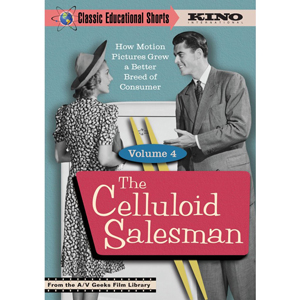
Taking the discs out of order, Volume 4 is The Celluloid Salesman, which purports to explain "How Motion Pictures Grew a Better Breed of Consumer". These pictures are outright long-form commercials for products or entire companies; some may have been used as TV filler and others seem designed as visual aids for live speakers. At least one carries a card stating that only company personnel may view the film - Quick! Turn the projector off before we're arrested! The intended audience might be the general public, a local business group, specific executives or the U.S. government. Just remember that one of these pictures might net an independent producer ten or twenty thousand dollars -- they weren't cheap. Someone really wanted to promote their product or corporate logo.
Movies Move People (1969, color, 23 min) Kodak. This show is nothing more than a sales reel to encourage companies to use film to propagate their ideas. Colorful graphics introduce a selection of effective film sequences. It's interesting that the first example up is a scare piece depicting a family in graphic car wreck -- maybe those seat belts really are a good idea! The on-screen host is Hugh Marlowe, whose semi-abstract speeches sometimes remind us of Don Draper of Mad Men.
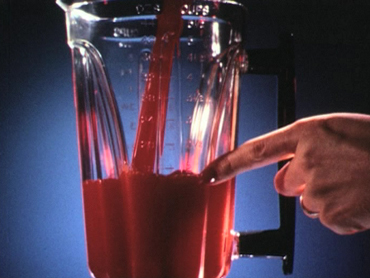
Comprehending Blending (1963, color, 18 min) Hamilton Beach / Portafilm. Yes, the future of domestic happiness boils down to the miracle of small household appliances. This rather long show kicks off a pattern we'll be seeing a lot: the educational aspect is a diversionary tactic that leads into a direct plug. After a long, nicely filmed overview of the quality built into every HB product, we finally get down to Subject A -- a countertop blender that is God's gift to modern man.
Doomsday for Pests (1946, color, 14 min) Sherwin Williams / Jerry Fairbanks. A colorful animated epic. A theater patronized by insects (a comment on this film's audience?) learns of a new paint additive laced with DDT, a derivative of a NERVE AGENT banned in 1972, after its negative ecological effects were publicized in Rachel Carson's Silent Spring. The cartoon bugs learn that their fate is sealed because humans are applying killer paint to everything in sight. See lots of bugs die horrible deaths! This must have been produced at the Paramount-Fleischer studio, as we hear familiar Fleischer music cues on the soundtrack.
Give the Lady What She Wants (1970s, color, 21 min) GATX / PC Prods. A bizarre approach to a boring topic ... all about specialized railway tank cars to carry vital chemicals and "stuff' to make life just swell for womenfolk. A stacked but dumb blonde enters the GATX corporate offices and is passed among eager staff members as she and we learn about the fabulous variety of (yawn) tank cars. A tough sell, and a confused one -- is the show touting the company's services, or trying to convince housewives that their lives depend on complex chemistry they know nothing about?
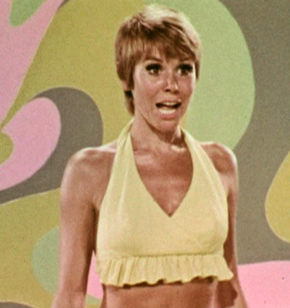
Freeze-In (1968, color, 16 min) Sears Roebuck & Co. / Calvin Productions. Sears sells its line of large freezers with inane, endless skit comedy patterned on the hit TV show "Laugh-In". Show regulars Judy Carne and Arte Johnson do all their usual schtick, she dancing in a bikini and he trotting out his sub-Peter Sellers German soldier routine. Painful in the extreme, but probably effective: at age 16, I remember thinking that Laugh-In was sophisticated humor.
The Adventures of Chip and Dip (1968, color, 20 min) Potato Chip Institute / Academy McLarty Prods. An absolutely stultifying experience. Sponsored by a syndicate of spud pushers an potato advocate group, this film relates the glorious heritage of the potato chip through history, as told by a pair of animated Irish Leprechauns. No potato famine here! The center of the show is the gleaming, automated chip assembly line, which may have impressed men's clubs and impressionable potential addicts students. I can see free bags of chips being handed out after the screening. I can also see the 20-minute running time allowing the guest speaker to catch a couple of quick drinks before facing his audience.
News Cavalcade (1965, B&W, 13 min) Sterling Movies. This may have been an experiment in "hidden persuasion" but it's really cinematic fraud at the elemental level, produced at a time when theatrical newsreels were almost extinct. The newsreel fashions bland "news stories" from innocuous government film -- except for the middle item that reports how tire manufacturers are engineering tires for greater safety than ever! And lots of new Ford Mustangs are seen too, rolling down the assembly line.
The Stage is Yours (1961, color, 13 min) National Cotton Council. An ode to retail selling, pitched directly to salespeople that presumably were herded together and forced to watch it. It's a "nice" appeal to balance out the tyrant sales manager hovering over you. Learn how to please the customer while pressing him to make more purchases and accept extra add-ons. And of course cotton clothing is what's being stressed. Pity the poor sales schlubb who knows that customers will respond better to more attractive or handsome salespeople, like the ones shown in the film.
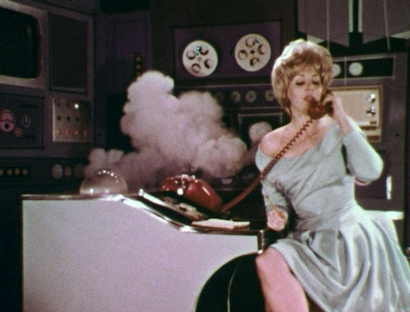
Miss Puff (1960+/-, color, 10 min) Labelon Toner. Sexism lives again. As it explains why that fancy photocopier in the office is a holy object (Mad Men has a scene about this exact subject), the movie uses a ditzy blonde answering the office phone to hard-sell the toner liquid. I wonder what the female Labelon workforce thought of the final scene, where the big customer also gets what sounds like a hot date with the babe who takes his order?
Goodbye to Garbage (1960, color, 5 min) General Electric. Mercifully short, this ode to the newfangled garbage disposal encourages America to stop throwing out trash. General Electric has a better idea: grind it up and dump it in the sewer system! We learn how a disposal works, all right ... the close-up, slow-motion photography is like watching your toothless Aunt May chew with her mouth open. Make it stop, please, I'll buy one!
This Is... Elk Country (1967, color, 10 min) Schlitz Brewing Company / Centralab /Edlin Film Productions. A leisurely camping & hunting trip to the great outdoors. The show appears to be about enjoying nature until it sneaks in ads for a new portable power gadget to bring all-electric comfort to the wild. And don't forget the alternate sponsor -- that cold mountain stream is perfect for chilling good ol' Schlitz brew. What's sorely lacking is a shot of some Elk relieving themselves upstream.
Ideas in Action (1966, color, 6 min) Westinghouse Electric / Jam Handy Organization. Another corporation gets into the "promote film as a tool of persuasion" act, the difference being that this much shorter piece concentrates on the kinetic energy film can generate through fast cutting and graphic text (some editor got to show off, if only anonymously). I mentally picture a room full of ad men proclaiming montage to be the Next Big Thing, while trying to grok paperbacks by Marshall McLuhan: "Is this hot, or is it cold?"

Your Daily Bread (1957, color, 12 min) American Bakers Association. This little slice of life saw a lot of use -- I believe they screened it in my High School. It's a good example of Institutional Advertising that simply shows how a product or a company is integral to our lives in a positive way. The theory is that once that link is created, we'll "think nice thoughts" about what was before a faceless company, and then seek out its individual products on our own. Bread is basic stuff -- you know, life itself!
Goodbye Weeds (1946, color, 18 min) Sherwin Williams / Jerry Fairbanks. A companion piece to "Doomsday for Pests", with a little less complicated animation used to illustrate the struggle against the most pressing issue facing modern man -- garden weeds. This time we get a polished drama and slick Hollywood personnel. With Donald Woods, Wanda McKay and J. Farrell McDonald as a faux-Irish golf groundskeeper.
A Summer Opportunity (1969, color, 14 min) Collier's. It's pretty hilarious to see Alistair Cook associated with this piece of high-toned flimflam. Having ceased publication of its magazine, the Collier's organization needs agents to sell encyclopedias. Cook pitches academics to work during their school breaks to get out the good word. Of course, it's all wrapped up in a soft sell of intellectual flattery and the promise of foreign adventure, peppered with a few success stories. But the job sounds like commission work with a pay-your-own-way plan, all arranged so the target teachers risk the money and time and the Collier's organization gets rich. Remember what Homer Simpson said: the big boys didn't get where they are by writing checks.

Kino's Volume 3, Safe... Not Sorry ventures into the realm of Safety pictures, movies designed to help children and adults avoid horrible fates or trips to the emergency room. The films are often revived as camp items because of their inclination to make people look profoundly stupid, which is always good for a laugh. Yet the companies and public agencies that sponsored the films had access to data suggesting that it was impossible to aim the films too low ... most people get hurt over the most trivial-sounding mistakes. The list mercifully contains no examples of Highway Safety films, those notorious gore-fests that elected to terrorize drivers into following the rules of the road. (Kino has an excellent long-form study and collection of these stomach-turners: Hell's Highway.) How to get people to alter their bad safety habits? Do you educate them politely, or scare the bejeesus out of them?
Don't Touch (1972, color, 7 min) Institute of Makers of Explosives. A pretty effective short -- some kids wanna play with a blasting cap, but one of them has the sense to call the police. The cops send an explosives worker to investigate -- with the kids just a few feet away. We get a nice speech about the benefits and dangers of high explosives and the direction is good, but the show plays like something forced on a negligent company by a judge. Although the police call that begins the show is about a definite threat to the public, the only responder is an employee of a private firm. He quickly absconds with the evidence of somebody's gross negligence.
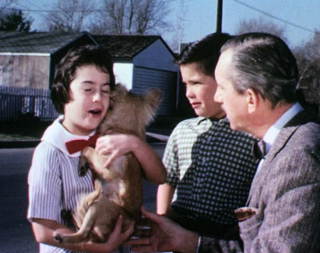
Dangerous Stranger (1972, color, 10 min) Sid Davis Prods. I've heard that this short was circulated forever, and re-filmed every ten years or so. A visiting policeman advises kids how to avoid going off with some stranger and "never being seen again". It's simple, clear, and scary as hell for parents, but a good way to let kids know that every rotten predator in creation may be just around the corner. Interesting casting choices for the molesters, pederasts and serial killers that approach the kids -- no freaks or sickos -- just ordinary looking guys. Funny, they never made the sequel to this film -- "How To Use Crayons To Escape the Dungeon of Doom".
Live and Learn (1951, B&W, 12 min) Sid Davis Prods. Look out, kid! The broken bones, burns and accidental stabbings come fast and furious in this regular treadmill of mayhem. Those damn youngsters just won't listen to the narrator and persist in drowning each other, jumping from roofs and setting themselves on fire. Frankly, every time we cut to the same patient doctor and nurse bandaging up another tragic victim, this one gets more and more funny.
Say No to Strangers (1963, color, 10 min) Irvmar Productions. A less-threatening alternative to Dangerous Stranger, this keeps things tame for smaller kids, easing into the disturbing content by offering clear rules to avoid disaster. A Jack & Jill pair walks home alone, carefully -- and seem to run into malefactors as surely as Red Riding Hood meets wolves. I say concentrate the cops in that one neighborhood, and the molesting scum will be wiped out for good. Nicely made, with cute kids and a reassuring lesson that policemen are our friends. It's just that kids in rougher parts of town probably have totally different images of policemen. And frankly, these films can't touch the sad fact that a great deal of the molestation, if not the outright murders, happens in the home.
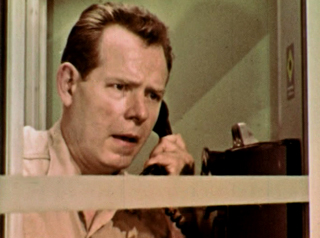
Ten Long Minutes (1961, color, 12 min) National Safety Council / Pilot Prods. This is an excellently scripted, directed and acted drama. A factory worker working a weekend shift learns that his family may have had an accident in the mountains; while waiting for the police to get back to him he imagines the consequences of a number of neglected small repairs and auto maintenance issues. Great scripting and editing, really well done.
Ghost Rider (1982, color, 15 min) Pennsylvania Department of Transportation. Somebody listened to "Tell Laura I Love Her" or saw Portrait of Jennie before writing this one. Want to promote safety on school buses? Make a story about a boy haunted by a cute teen ghost, the victim of an earlier bus tragedy. The kid becomes a hero, taking charge when an accident crashes the bus halfway off a steep cliff. Not bad at all. A big-deal production with an impressive slow-mo scene of the bus taking the big plunge, which I'm sure got cheers from school kids. An additional commentary track features the memories of the young non-actor who plays the hero. First day on the job, and the makeup person had to paint out a big blemish on his nose!
Lucky You (1958, color, 17 min) Jam Handy. Animation presents a menagerie of fantastic animals, each impervious to a particular threat: fire, gunshots, falls, etc. A robot man is unaffected when hit by cars, for example. But the cartoon points out that a fall wipes out the anti-hit robot, an arrow will puncture the floating anti-fall creature. The message is that although we don't have special powers and are vulnerable to all of these dangers, we're smart enough to avoid them. Clear enough, although the circus atmosphere and weird creatures are more of a distraction than a teaching tool.

One Got Fat (1963, color, 15 min) Interlude Films. A camp classic that probably traumatized its intended audience of youngsters, while their slightly older friends laughed their heads off. Edward Everett Horton narrates a fractured fairy tale about a bunch of monkeys (kids with tails and masks) riding their bikes to a picnic. One by one they disobey traffic rules and are wiped out. The slightly cynical narration is disturbing enough, but the bizarre masks look like evil brown skulls, with eyes that pop just before being hit by a truck or crushed by a steam roller (no kidding). Well, I guess it gets the message across.
Step Right Up (1977, color, 24 min) Film Communicators. Often chosen for compilation reels, this rather idiotic picture centers on a pea-brained handyman who finds 101 ways to get himself killed misusing ladders. And he's just trying to change a light bulb. It's far too long; sort of an Andrej Rublev of repetitive, idiotic jeopardy.
An Outbreak of Salmonella Infection (1954, color, 13 min) U.S. Public Health Service. This Air Force film shows what happens when bad kitchen practices sicken almost a hundred airmen with tainted chicken. Fly guys throw up on screen to dramatize the effects of cooks that don't wash a cutting board or heat leftovers to keep bacteria from running amuck. I can just see cooks at base installations seeing this show (which doubles as a how-to cooking lesson) and thinking -- gee, we better clean up our act. The film wouldn't have been made if the problem wasn't serious. I wonder what the protocol says to do when the 'wing attack plan R" go-code is issued, and every available flier has his head in a toilet.

Safety With Animals (1961, color, 12 min) Grover-Jennings Productions. Good advice being handed out here, about safety around dogs, horses, cats, etc., but the whole enterprise borders on child endangerment. A real tot tries to keep a hot dog away from an aggressive dog bigger than he his, and the camera watches passively as a boy purposely upsets a horse that could deliver a bone-crushing bite, without warning. I hope those animals were well trained! The movie says that it's fine to befriend stray dogs as long as you let the dog approach you, and not the other way around. But watch out for squirrels, which may have rabies.
Safety Harm Hides at Home (1977, color, 16 min) The Film Company. This misbegotten non-epic features "Guardiana", a half-baked Wonder Woman who rushes to save kids from boneheaded mistakes in the kitchen. Includes a feeble extended opening showing Guardiana's origin myth -- her magic accoutrements are gifts from aliens in a flying saucer. The pathetic costume appears to be made of household objects. You thought your student film was embarrassing? This one will make you feel better.
Trigger Happy Harry (1946, color, 21 min) National Rifle Association / Business Films. Before they ran public policy and made gun madness the end product of our democratic system, the NRA was a great institution dedicated to seeing that its members didn't accidentally blow their own heads off. This primer on common sense in gun handling focuses on a doofus named Harry. He continually points loaded weapons at people and wanders off begging to be shot by his own comrades. Clearly a crowd pleaser for beer-drinking members to hoot at while thinking of their own lucky goofs.

Our Obligation (1960, color, 24 min) Los Angeles Fire Department. This excellent picture could only have been made by a fire chief exasperated by city officials and voters that refuse to fund proper safety measures in aging public buildings. Beautifully shot in docu fashion (marginal acting not a problem), this saga imagines what might happen if one of L.A.'s dilapidated Junior High Schools went up in flames with kids inside. The fire call is delayed while a teacher, cut off from the rest of the school with a class full of 12 year-olds, tries to cope. The picture doesn't chicken out: students and teachers are killed by very convincing smoke and flames. Well judged and just exploitative enough to generate public outrage at those crooks in City Hall. I'll bet this show had an instant effect -- any group of parents seeing it would demand action.
Kino International's DVDs of Classic Educational Shorts are well organized and attractively designed; the films are all intact, although some have slightly off colors and some scratching. Except for collectors, no organization saved or archived these pictures until recent decades, and printing elements were certainly not saved. An obvious teaching tool for special situations, the series makes for stimulating, weird entertainment.
On a scale of Excellent, Good, Fair, and Poor,
The Celluloid Salesman & Safe... Not Sorry rates:
Educational film compilations: Excellent
Video: Good
Sound: Good
Supplements: Introductions by Skip Elsheimer.
Packaging: Keep cases (separate releases)
Reviewed: January 19, 2011
DVD Savant Text © Copyright 2011 Glenn Erickson
See more exclusive reviews on the Savant Main Page.
Reviews on the Savant main site have additional credits information and are often updated and annotated with reader input and graphics.
Also, don't forget the
2010 Savant Wish List.
T'was Ever Thus.
Return to Top of Page
|

